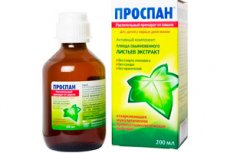Medical expert of the article
New publications
Preparations
Prospan for cough: what cough to take, analogues
Last reviewed: 04.07.2025

All iLive content is medically reviewed or fact checked to ensure as much factual accuracy as possible.
We have strict sourcing guidelines and only link to reputable media sites, academic research institutions and, whenever possible, medically peer reviewed studies. Note that the numbers in parentheses ([1], [2], etc.) are clickable links to these studies.
If you feel that any of our content is inaccurate, out-of-date, or otherwise questionable, please select it and press Ctrl + Enter.

The herbal medicine Prospan for coughs belongs to the group of expectorants and mucolytics, that is, it is an expectorant.
Indications Prospana for coughing
What kind of cough is Prospan used for? Like many other expectorants and mucolytic drugs, doctors prescribe Prospan for wet cough (productive) - in the symptomatic treatment of various infectious diseases of the upper respiratory tract, as well as acute and chronic bronchitis, which are accompanied by a cough with the formation of viscous bronchial exudate (sputum).
Release form
The manufacturer (Engelhard Arzneimittel GmbH & Co, Germany) produces:
- Prospan cough syrup (in 100 ml and 200 ml bottles);
- Prospan forte effervescent tablets (65 mg);
- Prospan cough drops (20 ml in a bottle);
- Prospan cough lozenges (26 mg each);
- Prospan cough solution (for oral administration) in 5 ml sticks.
Pharmacodynamics
Dry extract of ivy leaves (Hedera helix L.) of the Araliaceae family is the active ingredient in all forms of the cough remedy Prospan.
Its pharmacological action – secretolytic (liquefying sputum) and expectorant (improving mucociliary clearance and facilitating expectoration of sputum) – is due to such organic compounds as the pentacyclic triterpenoid hederagenin (systematic name – (3β)-3,23-dihydroxyolean-12-ene-28-oic acid), which is a triterpene saponin, as well as the glycoside α-hederin (also related to terpene saponins). [ 1 ], [ 2 ], [ 3 ]
According to research, hederagenin has hydroxyl, hydroxymethyl and carboxyl groups in its structure, which reduce the viscosity of bronchial secretions by increasing its hydrophilicity; it is quickly absorbed in the gastrointestinal tract, can overcome the blood-brain barrier and has a short half-life.
Pharmacokinetics
The instructions for all forms of this drug do not describe the pharmacokinetics, since it has not been fully studied due to the complexity of the structure of biologically active substances. However, researchers suggest that hederagenin is metabolized mainly by intestinal microflora.
Dosing and administration
Dosage of syrup for adults: three times a day, 5-7.5 ml; for children 6-12 years old – 5 ml; for children under six years old – 2.5 ml.
Dosage of Prospan solution for adults and children over 12 years old: one stick (undiluted, with water) three times a day; children 6-11 years old – one stick twice a day.
Prospan drops: Adults and children over 12 years old take 20 drops (three to four times a day); children two to three years old – 10 drops per dose; children under 12 – 15 drops.
Effervescent tablets (which need to be dissolved in 200 ml of water) are recommended to be taken by adults and children over 12 years of age, one tablet twice a day; children aged 7-12 years – half a tablet three times a day.
- Application for children
See - Prospan Cough Syrup for Children
Children under one year of age should not use Prospan drops, and children under six years of age should not use Prospan effervescent tablets or solution.
Use Prospana for coughing during pregnancy
During pregnancy and lactation, it is not recommended to use Prospan in any form.
Contraindications
Prospan syrup is contraindicated in the presence of congenital fructose malabsorption, glucose-galactose malabsorption and sucrose deficiency.
The drug is not prescribed for bronchial asthma.
Side effects Prospana for coughing
The most likely side effects of ivy leaf extract products include nausea, vomiting and diarrhea, as well as allergic reactions (skin flushing, angioedema and difficulty breathing).
Overdose
Exceeding the dosage leads to gastrointestinal disorders with nausea, vomiting and diarrhea.
Interactions with other drugs
Prospan for cough should not be taken with drugs that suppress the cough reflex.
Storage conditions
Prospan should be stored at a temperature no higher than +25°C, avoiding exposure to sunlight.
Shelf life
The shelf life is three years, but an opened bottle of syrup reduces the shelf life to three months.
Analogues
Analogues of Prospan are: syrups Gederal ivy, Gerbion ivy, Ritosse ivy, Bronchipret; Pectolvan ivy (syrup and capsules); syrup and drops Gedelix; syrups Lazolvan (Ambroxol), Fludex, etc.
Attention!
To simplify the perception of information, this instruction for use of the drug "Prospan for cough: what cough to take, analogues" translated and presented in a special form on the basis of the official instructions for medical use of the drug. Before use read the annotation that came directly to medicines.
Description provided for informational purposes and is not a guide to self-healing. The need for this drug, the purpose of the treatment regimen, methods and dose of the drug is determined solely by the attending physician. Self-medication is dangerous for your health.

